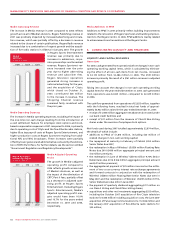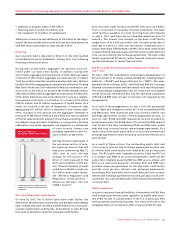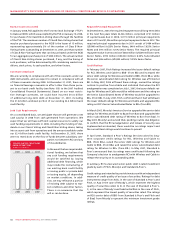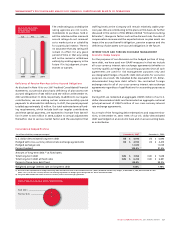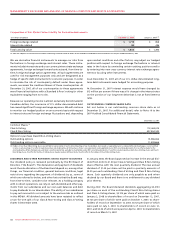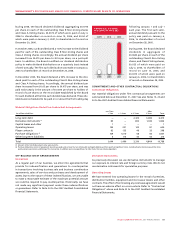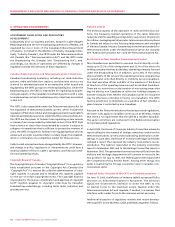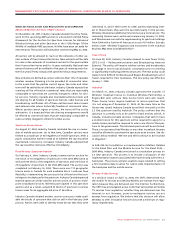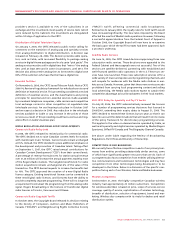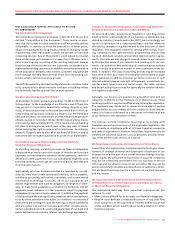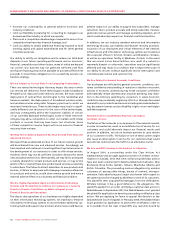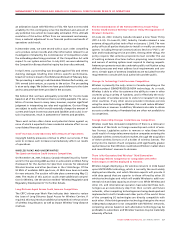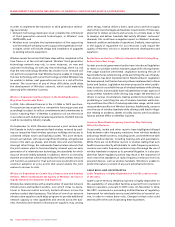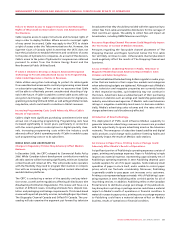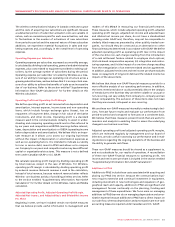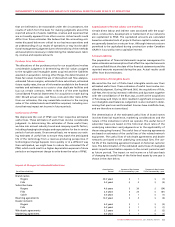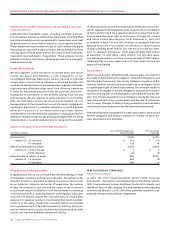Rogers 2007 Annual Report Download - page 58
Download and view the complete annual report
Please find page 58 of the 2007 Rogers annual report below. You can navigate through the pages in the report by either clicking on the pages listed below, or by using the keyword search tool below to find specific information within the annual report.
54 ROGERS COMMUNICATIONS INC. 2007 ANNUAL REPORT
MANAGEMENT’S DISCUSSION AND ANALYSIS OF FINANCIAL CONDITION AND RESULTS OF OPERATIONS
In the wireless voice and data market, Wireless competes primar-
ily with two other national wireless service providers and regional
players, and with resellers such as Virgin Mobile Canada, Primus,
Vidéotron, and other emerging providers using alternative wireless
technologies, such as WiFi “hotspots”. Wireless messaging (or one-
way paging) also competes with a number of local and national
paging providers and potential users of wireless voice and data
systems may find their communications needs satisfied by other
current or development technologies, such as WiFi “hotspots” or
trunk radio systems, which have the technical capability to handle
mobile telephone calls.
In 2008, an auction of AWS spectrum will take place. The auction
rules set aside 40 MHz of spectrum that only new entrants can bid
on. In addition, new entrants have the right to roam on incumbents’
networks at commercial rates, both in-territory (for five years) and
out-of-territory (for 10 years). These rules will likely create addi-
tional competition for Wireless. See the section entitled “Wireless
Regulation and Regulatory Developments” for further details.
Cable Competition
Canadian cable television systems generally face legal and illegal
competition from several alternative Canadian multi-channel broad-
casting distribution systems, illegal U.S. direct broadcast satellite
service providers, terrestrially-based video service providers, satellite
master antenna television, and multi-channel, multi-point wire-
less distribution systems, as well as from the direct reception by
antenna of over-the-air local and regional broadcast television
signals. In addition, the availability of television shows and mov-
ies on the Internet is increasingly becoming a direct competitor to
Canadian cable television systems.
Cable’s Internet access services compete generally with a number of
other Internet Service Providers (“ISPs”) offering competing residen-
tial and commercial dial-up and high-speed Internet access services.
The Rogers Hi-Speed Internet Express, Extreme, Extreme Plus, Lite
and Ultra-Lite services, where available, compete directly with Bell’s
DSL Internet service in the Internet market in Ontario, with the DSL
Internet services of Aliant in New Brunswick and Newfoundland
and Labrador, and various DSL resellers in local markets.
Rogers Retail competes with other DVD and video game sales
and rental store chains, as well as individually owned and oper-
ated outlets and, more recently, online-based subscription rental
services and illegally downloaded movies and television shows.
Competition is principally based on location, price and availability
of titles. Rogers Retail also competes with other retail stores that
sell wireless and video products of our competitors.
One of the biggest forces for potential change in the telecommu-
nications industry is the threat of substitution of the traditional
wireline video, voice and data services by new technologies.
Wireless is often cited as an eventual replacement for the standard
home telephone, although experience shows that mobile phones
are used primarily as second lines. The popularity of mobile phones
among younger generations has resulted in some abandonment of
wireline service. Internet delivery has the potential to be a threat
to voice and video service delivery. Younger generations use the
Internet as a substitute for traditional wireline telephone and tele-
vision services.
Media Competition
Broadcasting’s radio stations compete with the other stations in
their respective market areas as well as with other media, such as
newspapers, magazines, television, outdoor advertising, direct
mail marketing and the Internet. Competition within the radio
broadcasting industry occurs primarily in individual market areas,
amongst individual market stations. On a national level, Media’s
Broadcasting division competes generally with other larger radio
operators, which own and operate radio station clusters in markets
across Canada. Additionally, over the past several years the CRTC has
granted additional licences in various markets for the develop ment
of new radio stations, which in turn provide additional competi-
tion to the established stations in the respective markets. Two new
licenced satellite subscription-based radio services now provide
competition to Broadcasting’s radio stations. New technologies,
such as on-line web information services, music downloading, MP3
players and on-line music streaming services, provide competition
for broadcasting radio stations’ audience share.
On a product level, The Shopping Channel competes with various
retail stores, catalog retailers, Internet retailers and direct mail
retailers. On a broadcasting level, The Shopping Channel competes
with other television channels for viewer attention and loyalty, and
particularly with infomercials selling products on television.
The Canadian magazine industry is highly-competitive, compet-
ing for both readers and advertisers. This competition comes from
other Canadian magazines and from foreign, mostly U.S., titles
that sell in significant quantities in Canada. In the past, the com-
petition from foreign titles has been restricted to competition for
readers as there have been restrictions on foreigners operating in
the Canadian magazine advertising market. These restrictions were
significantly reduced as a result of the enactment in 1999 of the
Foreign Publishers Advertising Services Act (Canada) and amend-
ments to the Canadian Tax Act. Increasing competition from U.S.
magazines for advertising revenues is expected in the coming years.
On-line information and entertainment websites compete with the
Canadian magazine publications for readership and revenue.
OMNI, Citytv and Sportsnet compete principally for viewers and
advertisers with television stations that broadcast in their local
markets. These include Canadian television stations as well as
U.S. border stations, specialty channels and increasingly with
other distant Canadian signals and U.S. border stations given the
time-shifting capacity available to digital subscribers. On-line infor-
mation and entertainment and entertainment websites, and video
downloading compete with OMNI, Citytv and Sportsnet for share
of viewership.
RISKS AND UNCERTAINTIES AFFECTING OUR BUSINESSES
Our business is subject to risks and uncertainties that could result
in a material adverse effect on our business and financial results.
A discussion of the risks and uncertainties to us and our subsidiar-
ies, as well as a discussion of the specific risks and uncertainties
associated with each of our businesses, is presented below.


